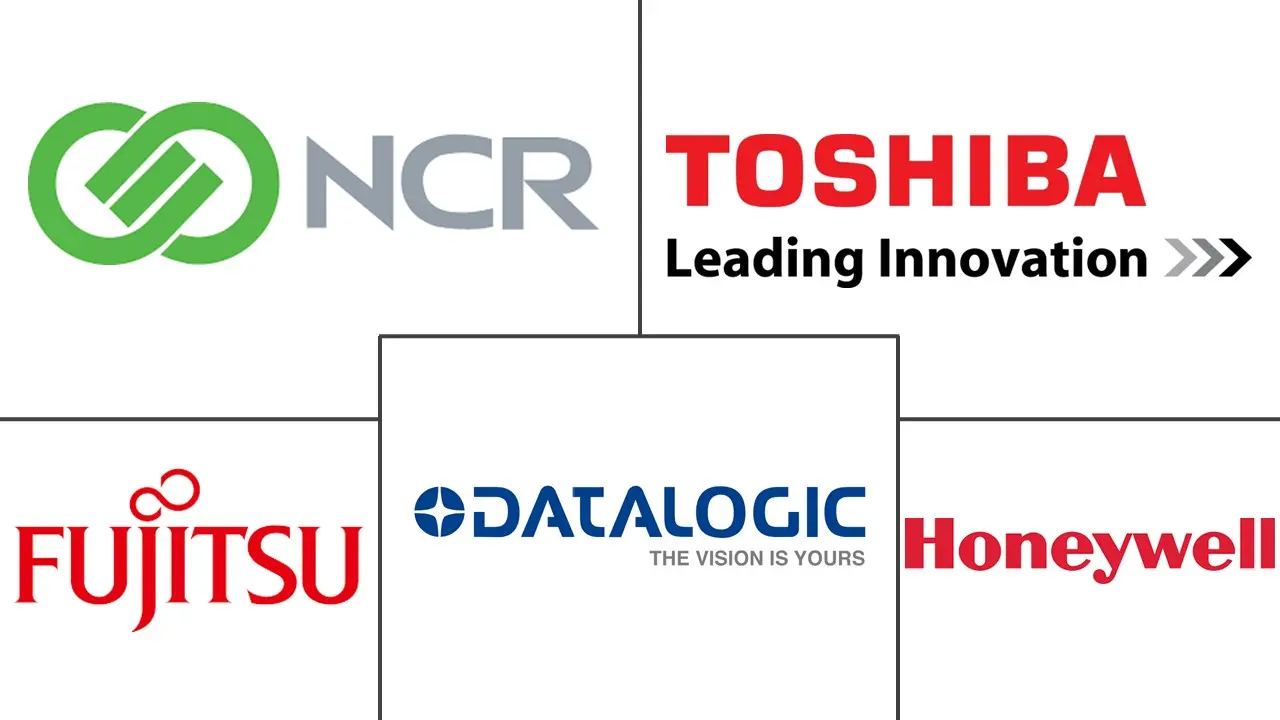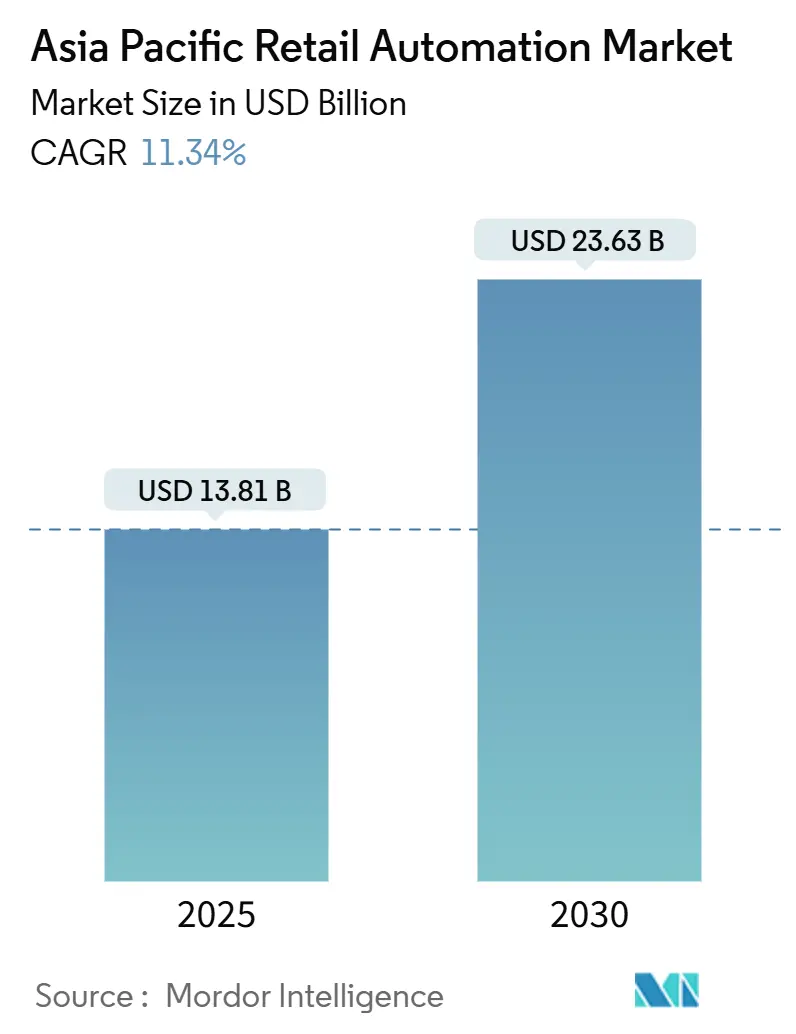
Asia Pacific Retail Automation Market Analysis by Mordor Intelligence
The Asia Pacific Retail Automation Market size is estimated at USD 13.81 billion in 2025, and is expected to reach USD 23.63 billion by 2030, at a CAGR of 11.34% during the forecast period (2025-2030).
- One of the primary factors driving the growth of the retail automation market is the increase in demand for advanced automated systems in retail across the Asia Pacific. Retail automation helps handle triggering responses, interact with other digital systems, and handle data. Lower operational risk, lower costs, a better customer experience, and increased productivity are just a few advantages of using this software. The market in the region is expected to rise significantly due to the high rate of enterprise adoption of process management and automation solutions.
- Additionally, the rise in operational business changes brought on by the pandemic-induced work-from-home trend is one of the primary drivers of the market's expansion. Adopting technologies like AI, machine learning, and others and adjusting business procedures across companies have a positive impact on the sector.
- The number of physical stores is gradually rising in developing nations throughout the Asia Pacific. Most people choose to purchase daily necessities from stores because they are convenient. As a result, some customers still favor shopping in actual stores, despite the growth of e-commerce. The development of technologies in the retail sector will influence the number of customers entering physical stores. Businesses are integrating automated technologies into their physical storefronts due to their benefits. As a result, the retail automation market for in-stores is anticipated to grow in the coming years.
- The market for automation solutions is anticipated to be driven by an increase in retail outlets, the retail sector, and the adoption of digitization in the retail sector across developing nations like India, China, Japan, Singapore, and others. For instance, according to the government, India currently has the fourth-largest retail market in the world.
- One of the major factors driving the market's expansion is the expansion of retail stores. For instance, The Asian Development Bank (ADB) signed a USD 15 million equity investment agreement with DALI Hard Discount in March 2023 to help the company expand its network of cold storage facilities, distribution centers, and retail stores in the Philippines, resulting in the creation of at least 4,300 new jobs. Such investments will fuel the demand for retail automation solutions and goods.
- Moreover, the retail automation market is expanding as a result of the widespread use of contactless payment methods. Paying bills has become simple due to mobile payment gateways like Apple Pay and Samsung Pay. As a result, many retailers are implementing technologies like NFC POS terminals, which enable mobile payments. The widespread use of contactless EMV cards will aid NFC POS terminal adoption.
- Post-pandemic pushed retailers to invest in automation technology (such as robotic picking, automated inventory management, and analytics reporting, among others) in order to increase operational effectiveness and cut labor costs. For instance, using robots and deep learning to pick items off store shelves saves a lot of time and money compared to doing it manually. Supermarkets want to protect their employees while satisfying customers' ongoing demand for prompt delivery, which has increased due to the COVID-19 pandemic.
Asia Pacific Retail Automation Market Trends and Insights
Barcode Readers are Expected to Hold Significant Share
- Barcodes translate product information into bars and alphanumeric characters, which makes inventory tracking in warehouses and checkout lines much quicker and simpler. Bar codes' main business advantages include accuracy, inventory control, cost savings, simplicity, and speed. Barcodes allow retailers to keep track of their inventory and quickly price and sell their products.
- Increasing demand for handheld barcode readers/ scanners across various industry verticals, including transportation and logistics, warehouse, healthcare, hospitality, oil, and gas, etc., is one of the key trends in the retail automation market Asia Pacific. For instance, handheld barcode readers/scanners make inventory management and asset tracking easier. Handheld barcode readers/scanners are often small and lightweight, making them ideal for covering large areas at end-users like warehouses.
- A barcode scanner aids inventory tracking, checkout flow, and accurate information recording. The most common setup for a barcode scanner is a standalone scanner linked to a POS system. This enables the cashier to quickly scan the items from a customer's shopping cart and add them to the bill. The standalone inventory scanners, portable devices designed to record stock information directly on them, are available to warehouse workers or stocktake staff.
- The retail industry now uses automation more frequently due to advancements in technology. One sector that has benefited the most from barcode technology is the retail sector. Due to the benefits of automated retail, more people are now aware of the advantages of automation in retail operations, including purchase/sales services, inventory optimization, and other benefits expected to drive market growth.
- The use of barcoding technology can help customers save time and money and enhance customer service. Customers can scan the barcodes on the products they are interested in, and the prices will be displayed on the screen thanks to barcode systems used in retail stores. Customers can look through racks of clothing or shelves of books to find the price tag, which speeds up the shopping process.
- The market for barcode readers is anticipated to expand steadily. The rise in retail establishments in APAC nations like China, India, Vietnam, and South Korea is a factor in the high demand for barcode scanning equipment. Recently, Mango announced that it had added a 5,381 square foot store to Singapore's Parkway Parade shopping center, bringing the total number of its retail locations nationwide to more than 10. Barcode reading devices will become more popular due to these expansion investments.
- Moreover, the other two main factors driving market expansion are the expansion of e-commerce and the rising demand for contactless payment options. This pattern was made worse by the COVID-19 pandemic as companies shifted to contactless operations to preserve their social distance.
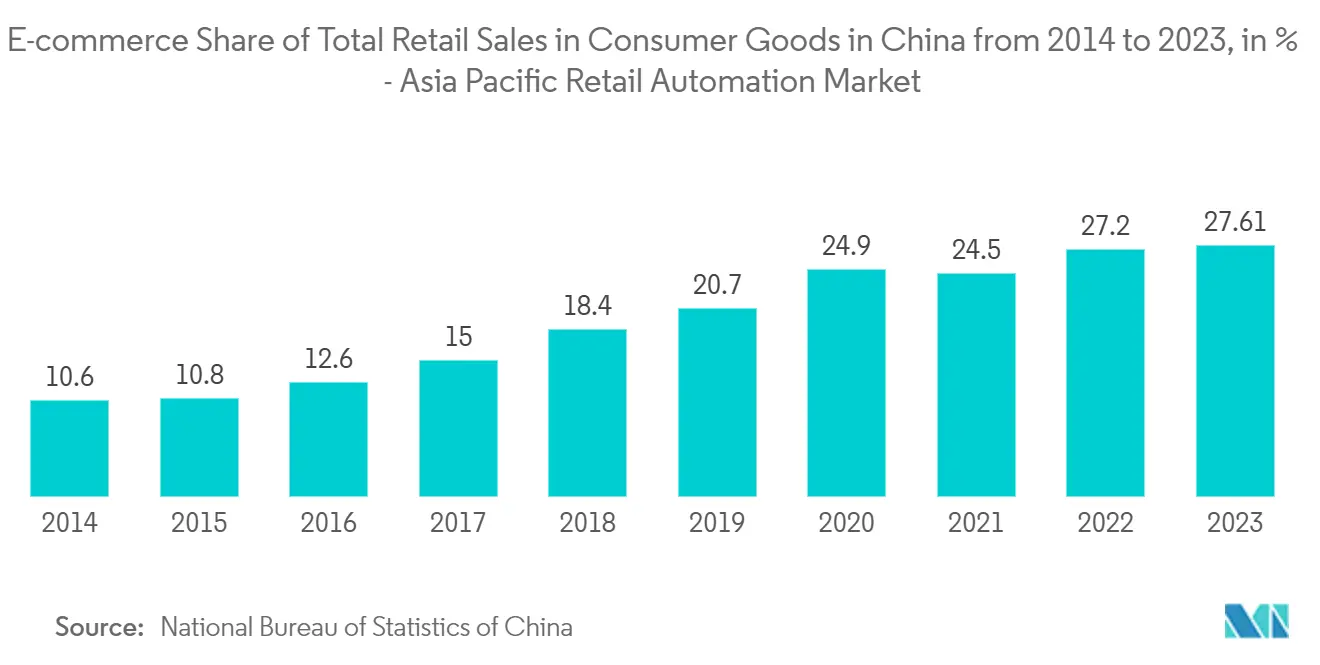
India is Expected to Hold a Major Share of the Market
- The India retail automation market is experiencing significant growth, driven by technological advancements and changing consumer preferences. There is an increasing demand for personalized shopping experiences and contactless payment options, which are pushing retailers to adopt automated solutions.
- The integration of autonomous mobile robotics (AMR) and advanced point-of-sale (POS) systems is transforming retail operations. These technologies not only enhance efficiency but also improve customer satisfaction through quicker service delivery.
- The competitive landscape features major players such as Amazon, Honeywell, NCR Corporation, and Toshiba, all contributing to advancements in retail automation solutions. These companies are focusing on strategic partnerships and technological innovations to enhance their offerings and capture market share.
- Due to the expansion of economies, the market is anticipated to experience significant growth as it meets the demand in the logistics automation segment. Additionally, the market is expected to be negatively impacted by the increase in investments made by manufacturers and suppliers in installing automation solutions at warehouses and distribution centers.
- For instance, recently, the Karnataka government and ESR India, a division of the Hong Kong-based real estate company focused on building and managing logistics and real estate for the new economy in the Asia-Pacific, signed an agreement for ESR India to invest INR 2,500 crore (USD 286.81 million) in the state. The company will construct industrial and logistics parks, urban distribution centers, and data centers in the state as part of the MoU. Such investments are anticipated to shrink the market significantly.
- As per Inc42, in 2023, the e-commerce sector received a total of 191 funding deals in India. The deal count was the highest in 2022 at 300 deals. The e-commerce sector received about USD 4 billion in funding during the same year.
- Overall, the India Retail Automation Market is poised for significant growth over the next decade, driven by technological innovations and evolving consumer demands. As retailers increasingly adopt automation solutions, the market will likely expand, presenting numerous opportunities for businesses to enhance productivity and customer satisfaction.
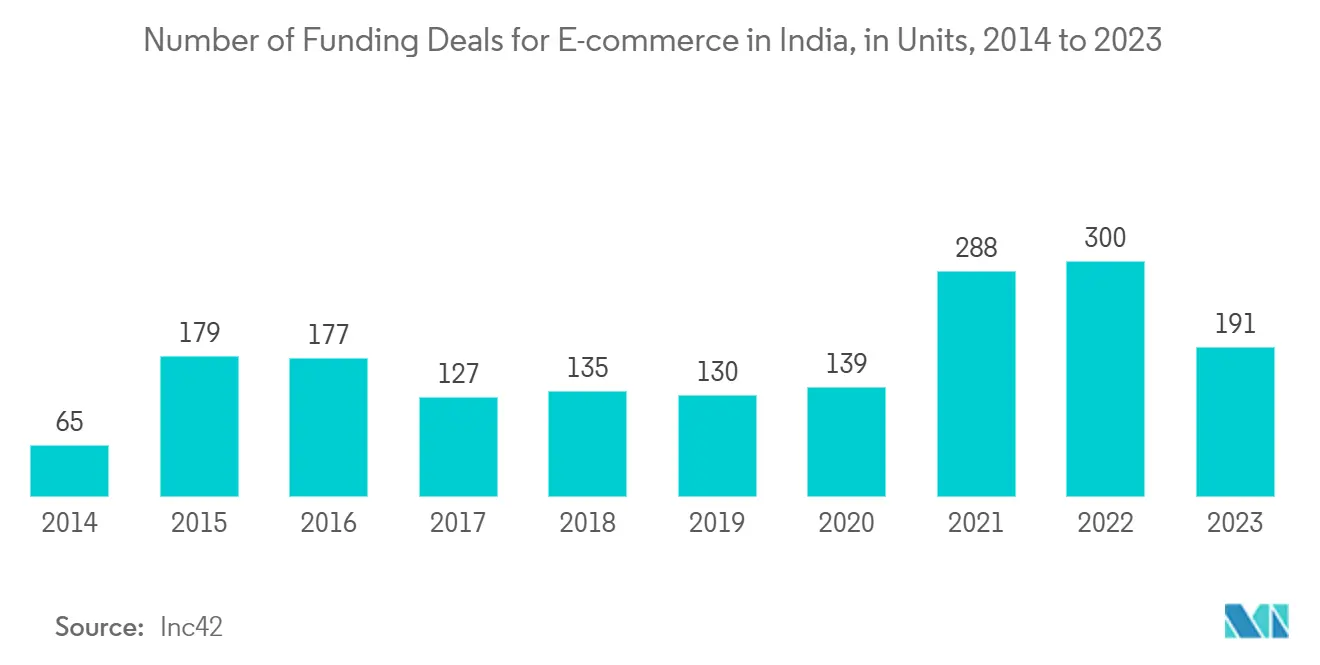
Competitive Landscape
Asia Pacific Retail Automation Market is fragmented. Some of the major players in the market are Fujitsu Ltd., Toshiba Corporation, Seiko Epson Corporation, Honeywell International Inc., NCR Corporation, and Datalogic S.P.A. Recent Developments made in this sector are:
The Asia Pacific Retail Automation Market is set for robust growth driven by technological advancements, increasing labor costs, and a booming e-commerce sector. As retailers continue to embrace automation solutions, they will enhance operational efficiency, improve customer experiences, and stay competitive in a rapidly evolving retail landscape.
Asia Pacific Retail Automation Industry Leaders
-
Datalogic S.P.A
-
Fujitsu Limited
-
NCR Corporation
-
Honeywell International Inc.
-
Toshiba Global Commerce Solutions
- *Disclaimer: Major Players sorted in no particular order
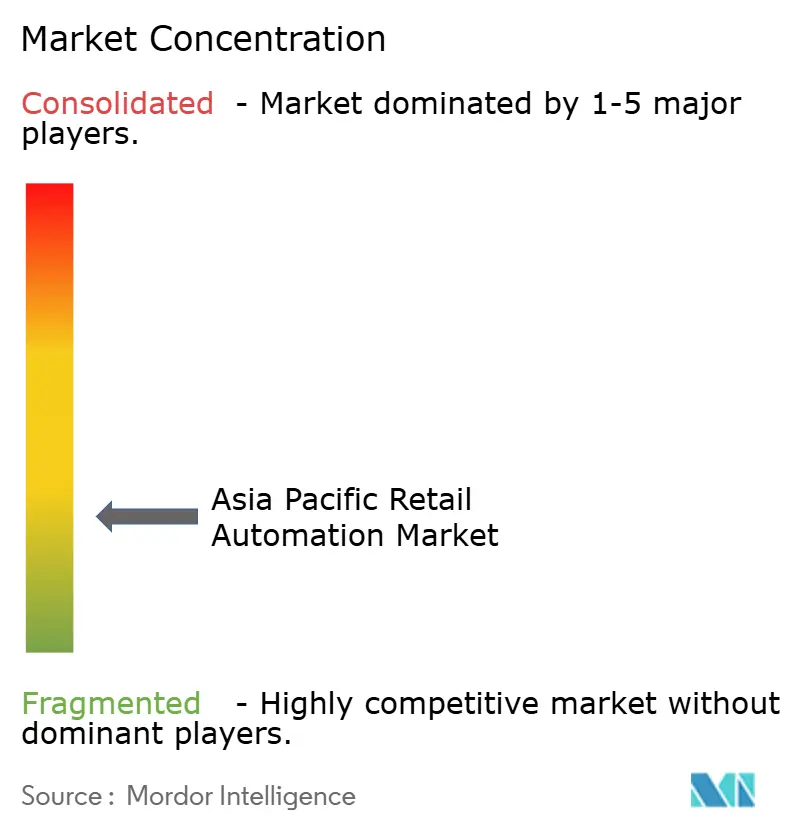
Recent Industry Developments
- September 2024: AutoStore announced a game changer for grocery retailers as company moves towards Product 2.0 strategy. Automated fulfilment solutions specialist AutoStore has introduced new Grid capabilities: the AutoStore Multi-Temperature Solution, an expanded 18-Level Grid, a Motorised Service Vehicle, and enhancements to its cube control software.
- January 2025: WSS has deployed Aptos ONE PoS across its store operations and customer engagement strategies. Dozens of WSS stores went live on it immediately prior to the holiday shopping period, with the remainder set to adopt the solution in early 2025. The deployment is soon expected to be launched in Asia region.
Asia Pacific Retail Automation Market Report Scope
The term retail automation refers to the use of computers and technology to create processes, systems, and workflows that operate independently and with little or no human intervention.
Asia Pacific Retail Automation Market is segmented by product type (point-of-sale systems requiring manual intervention and unattended terminals), by product (barcode reader, weighing scale, currency counter, bill printer, cash register, card reader, kiosks, self-checkout systems), by industry vertical (food/non-food, oil & gas, transportation & logistics, health & personal care, hospitality), and country. The market sizes and forecasts are provided in terms of value (USD) for all the above segments.
| Point-of-Sale Systems Requiring Manual Intervention |
| Unattended Terminals |
| Barcode reader |
| Weighing scale |
| Currency Counter |
| Bill Printer |
| Cash Register |
| Card Reader |
| Kiosks |
| Self-Checkout Systems |
| Others |
| Food/Non-Food |
| Oil and Gas |
| Transportation and Logistics |
| Health and Personal Care |
| Hospitality |
| Others |
| China |
| India |
| Japan |
| South Korea |
| Rest of Asia Pacific |
| Product Type | Point-of-Sale Systems Requiring Manual Intervention |
| Unattended Terminals | |
| Product | Barcode reader |
| Weighing scale | |
| Currency Counter | |
| Bill Printer | |
| Cash Register | |
| Card Reader | |
| Kiosks | |
| Self-Checkout Systems | |
| Others | |
| End-user Application | Food/Non-Food |
| Oil and Gas | |
| Transportation and Logistics | |
| Health and Personal Care | |
| Hospitality | |
| Others | |
| Country | China |
| India | |
| Japan | |
| South Korea | |
| Rest of Asia Pacific |
Key Questions Answered in the Report
How big is the Asia Pacific Retail Automation Market?
The Asia Pacific Retail Automation Market size is expected to reach USD 13.81 billion in 2025 and grow at a CAGR of 11.34% to reach USD 23.63 billion by 2030.
What is the current Asia Pacific Retail Automation Market size?
In 2025, the Asia Pacific Retail Automation Market size is expected to reach USD 13.81 billion.
Who are the key players in Asia Pacific Retail Automation Market?
Datalogic S.P.A, Fujitsu Limited, NCR Corporation, Honeywell International Inc. and Toshiba Global Commerce Solutions are the major companies operating in the Asia Pacific Retail Automation Market.
What years does this Asia Pacific Retail Automation Market cover, and what was the market size in 2024?
In 2024, the Asia Pacific Retail Automation Market size was estimated at USD 12.24 billion. The report covers the Asia Pacific Retail Automation Market historical market size for years: 2019, 2020, 2021, 2022, 2023 and 2024. The report also forecasts the Asia Pacific Retail Automation Market size for years: 2025, 2026, 2027, 2028, 2029 and 2030.
Page last updated on:
Asia Pacific Retail Automation Market Report
Statistics for the 2025 Asia Pacific Retail Automation market share, size and revenue growth rate, created by Mordor Intelligence™ Industry Reports. Asia Pacific Retail Automation analysis includes a market forecast outlook for 2025 to 2030 and historical overview. Get a sample of this industry analysis as a free report PDF download.
